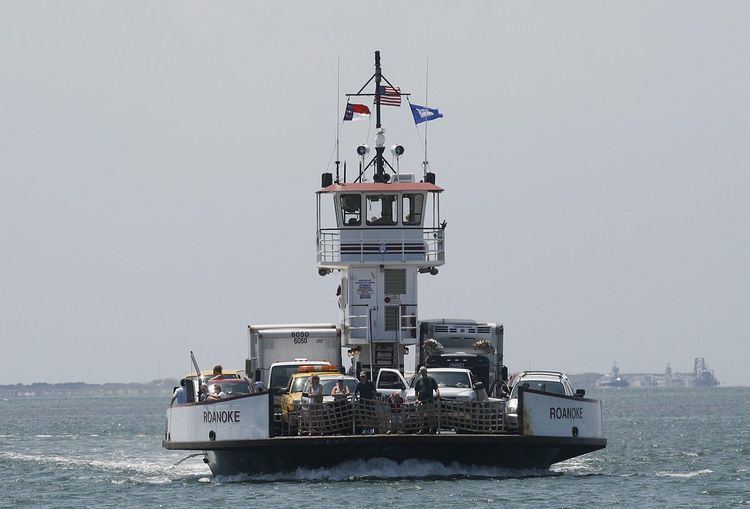 | ||
The North Carolina Department of Transportation Ferry Division is a branch of NCDOT that is responsible for the operation of over two dozen ferry services that transport passengers and vehicles to several islands along the Outer Banks of North Carolina.
Contents
Three other inland, cable ferries — the Elwell Ferry, Parker's Ferry and Sans Souci Ferry — continue in operation, under the oversight of the North Carolina Department of Transportation.
History
Ferries have always played a vital role to the residents and visitors of Eastern North Carolina. The first ferries began in the mid-1920s when Captain J.B. "Toby" Tillett established a tug and barge service across Oregon Inlet along North Carolina's Outer Banks.
In 1934, the North Carolina Highway Commission recognized the importance of this service to residents and began subsidizing Tillett's business. These subsidies kept tolls at an affordable level. In 1942, the Highway Commission began full reimbursement to eliminate the tolls. Tillett was fully subsidized until 1950 when his business was sold to the state.
In 1947, the Commission purchased the ferry operations of T.A. Baum, who operated a route that ran across Croatan Sound and linked Manns Harbor and Roanoke Island. This became the first route of the N.C. Ferry System.
Today
The North Carolina Department of Transportation's Ferry Division extends over seven routes, one emergency route, has 22 ferries and employs over 400 workers. The operations are supported by a full service shipyard at Manns Harbor and 10 support vessels, including dredge, military-style landing craft utility vehicles (LCUs), tugs, and barges. The Ferry Division operates over 200 sailings, with the ferries covering 1200 miles each day. The system includes the world's longest fare-free ferry route.
Each year, North Carolina ferries transport nearly 1 million vehicles and more than 2 million passengers across five separate bodies of water - the Currituck and Pamlico sounds and the Cape Fear, Neuse and Pamlico rivers.
Ferries also carry essential goods to water-locked communities. Many residents depend on the ferries for transportation to school, work, and other needed services.
Hatteras Class
The North Carolina Ferry System operates seven Hatteras Class ferries. These Vessels draft only 4 feet, and are designed for the shallow waters and shifting shoals of Eastern North Carolina. Originally designed to carry 150 passengers, these ferries have been downrated to carry only 149 passengers with the introduction of new regulations regarding ferries capable of carrying 150 or more passengers.
River Class
The Ferry System operates nine River Class ferries. These boats are designed for heavy, abusive use, and are double-ended (except the Hunt), meaning they do not have to turn around at the docks. This feature saves time on busy river routes. River class ferries are slowly replacing the older Hatteras class ferries.
Sound Class
The North Carolina Ferry System operates six Sound Class ferries. These ferries are the largest in the system, able to carry up to 50 cars. These Ferries are designed to withstand the abuse of constantly traversing the shallow, turbulent waters of the Pamlico Sound. The M/V Pamlico has been sold to Cross Sound Ferry of New London, CT. The M/V Pamlico is the sister ship of the M/V Sliver Lake.
Routes
Emergency Route
Tolls
The Ferry System today relies heavily on taxpayer subsidies, resulting in a one-way car toll of only $5 for the Cape Fear route and $15 for the Cedar Island and Swan Quarter routes. In recent years, the rough economy has forced the state to consider adding and increasing tolls so one-way car tolls for the Neuse River route would be $3; The Cape Fear River, Pamlico River, Currituck Sound and Hatteras routes would be $7; and the Cedar Island and Swan Quarter routes would be $25. The Department of Transportation has also considered tolling the Bonner and Dare Bridges and the legislature has created the North Carolina Turnpike Authority in an attempt to raise revenues. As of the end of the 2014 legislative session, however, it appears as though none of the ferry or bridge toll increases will take place.
